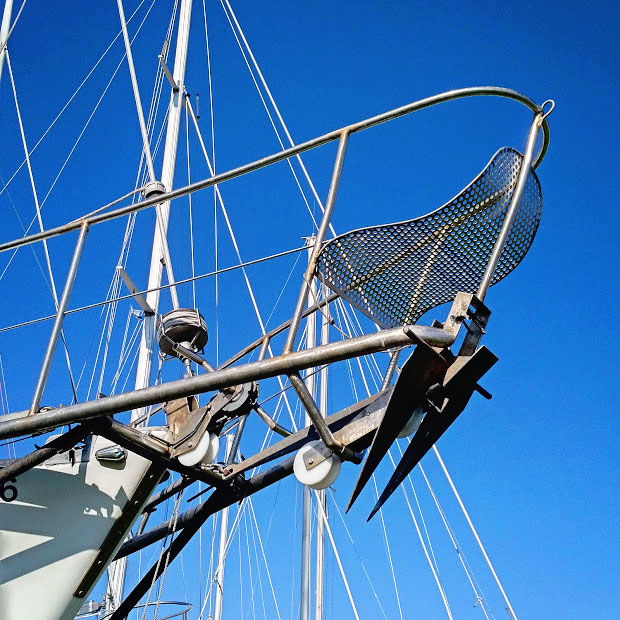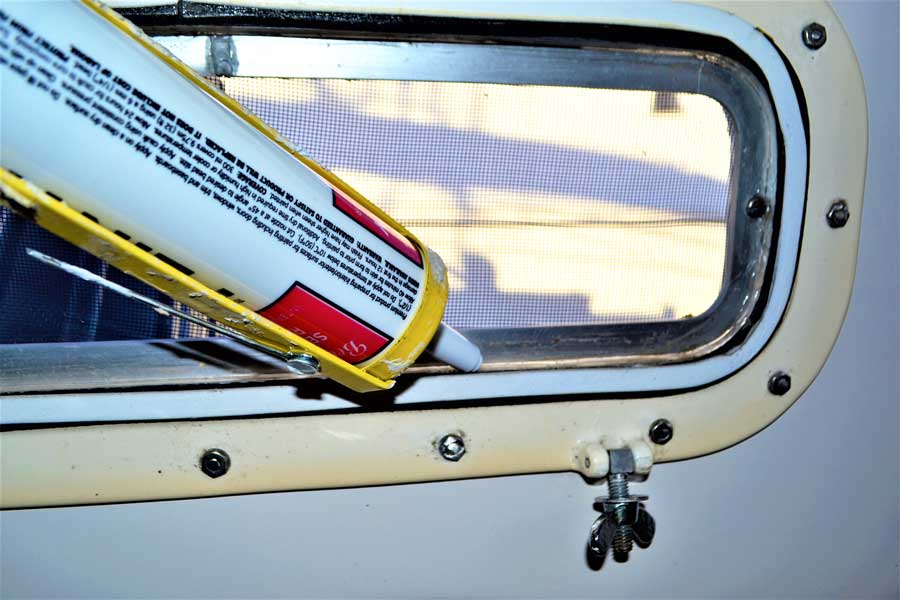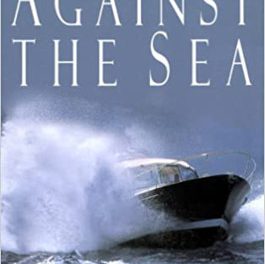Dogwatch Kudos
I want to express my appreciation for a tip I got in The Dogwatch today (“LED Light and RFI Feedback,” November 2019). I had seen the earlier RFI/LED article and had made a mental note to check if my LED tricolor interfered with my masthead VHF. Reading the readers’ feedback, a note from Brent Putnam triggered a light bulb in my head. My cheap and infrequently used AM/FM stereo had developed a bad static problem. I had pulled it, checked the antenna, power and speaker leads, and gave it a gentle whack. No better. My troubleshooting skills exhausted, I resigned myself to replacing it someday. After reading Mr Putnam’s mention of USB chargers giving RF interference, I unplugged the Chinese panel mount unit I had installed nearby. Problem fixed. Thanks to Good Old Boat and your readers.
–John Churchill, Nurdle, 1979 Bristol 35.5 CB
Dog Phobias?
 Reading about ancraophobia and anemophobia in the November issue of The Dogwatch makes me wonder whether these anxieties can also apply to dogs. It’s ironic, but the little starving puppy we found on an uninhabited island in the Kuna Yala, and who sailed more than 8,000 miles with us for two years before we returned to land, is now clearly experiencing this problem. Thunderstorms don’t alarm her, but when there’s a big wind blowing, she’s a mess. It’s especially bad if the breeze randomly slams a door shut in the house, so if a big wind is forecast, I go around propping doors with workboots to preclude this source of terror. I don’t want to medicate her with the typical drugs that would make her all dopey. I’m considering CBD oil for dogs as a possible alternative. It makes me sad to see her so scared, and especially to think that she grew up on a sailboat in big water. But, maybe we all gain a few weird fears as we grow older. Does anybody else have a dog who suffers ancraophobia?
Reading about ancraophobia and anemophobia in the November issue of The Dogwatch makes me wonder whether these anxieties can also apply to dogs. It’s ironic, but the little starving puppy we found on an uninhabited island in the Kuna Yala, and who sailed more than 8,000 miles with us for two years before we returned to land, is now clearly experiencing this problem. Thunderstorms don’t alarm her, but when there’s a big wind blowing, she’s a mess. It’s especially bad if the breeze randomly slams a door shut in the house, so if a big wind is forecast, I go around propping doors with workboots to preclude this source of terror. I don’t want to medicate her with the typical drugs that would make her all dopey. I’m considering CBD oil for dogs as a possible alternative. It makes me sad to see her so scared, and especially to think that she grew up on a sailboat in big water. But, maybe we all gain a few weird fears as we grow older. Does anybody else have a dog who suffers ancraophobia?
–Wendy Mitman Clarke, Good Old Boat senior editor
Some Advice for Capt. Rob
Regarding the letter from Capt. Rob in the November issue of The Dogwatch, about the starting problems he is having: I have a Yanmar SB12, which is also a small, single-cylinder diesel. When you turn your motor over by hand with the compression release engaged, each time the piston passes through top dead center, you should be able to hear the injector make a distinct “squoit” noise as it squirts a drop of fuel into the combustion chamber. If you do not hear this noise, the motor will never start, and you probably have an issue with air in the high-pressure side of the fuel line. It is also possible that the injector is bad, but this is much less likely and most certainly not the issue if the engine was running okay and now it won’t start. Learn to recognize this sound and you’ll always be able to tell if the motor is going to start or not.
–Homer Shannon, Cinderella, Bristol 29.9
I saw the letter in the November issue of The Dogwatch, about Capt. Rob’s diesel engine problem. I had a real interesting experience with the fuel system on my Pacific Seacraft 31. I had the marina change out my fuel lines and service the primary fuel filter (Racor 500FG). Afterward, I started experiencing air leaks in the suction side (before the electric and engine-driven fuel pumps). Soon after I’d begin to see air bubbles through the Racor filter inspection bowl glass, the engine would lug and die.
The first thing I found was the O-ring inside the filter cap had not been seated properly and was damaged. I replaced this O-ring and the engine ran for 45 minutes without a problem.
But several weeks later, it started lugging and dying again. I got pretty good at quickly bleeding the air and limping back to the marina! I started thinking I had something wrong at the fuel tank pickup, so I started removing hoses from hose barbs and inspecting the fittings.
I found that all the fuel hose was 5/16-inch and the barbed fittings were ¼-inch. Seems either the marina did not have ¼-inch fuel hose and substituted 5/16, or the previous owner/mechanic had changed to 5/16 at some time over the boat’s 29-year life. Changing to ¼-inch hose seems to have solved the problem.
By the way, in the fall of 2018 I attended a diesel teardown class in Chicago; followed by a diesel rebuild session in the spring of 2019. Best thing I have ever done for myself in regards to understanding the iron beast.
–Daryl Clark
The Most Unusual Things: Feedback
Last month we said we’d share the most unusual man-made thing we’d seen from a boat, and the most unusual wildlife we’d seen from a boat—not necessarily the coolest thing, but the most unusual, the thing others are least likely to report. And we put it to the readers, wondering what others have seen while sailing. We’re surprised at the low number of responses, but we got some very good ones.

First, as promised, here are the most unusual things we’ve seen, both sightings within weeks of each other. It was early fall 2013 and we were sailing our 1978 Fuji 40 down from Alaska, on our way to Southern California. It was then two years after the tsunami that triggered Japan’s Fukushima Daiichi nuclear disaster and reports of Japanese stuff washing up on Pacific Northwest beaches had been coming in all summer. As we sailed along the desolate coastline of the northern end of British Columbia’s Vancouver Island, we started seeing things in the water, Japanese things. In remote anchorages along that coastline, we found beaches covered in Japanese goods, nearly all plastic. There were lots of oyster floats, and lots of things we couldn’t identify, but most disturbing were the recognizable consumer goods.
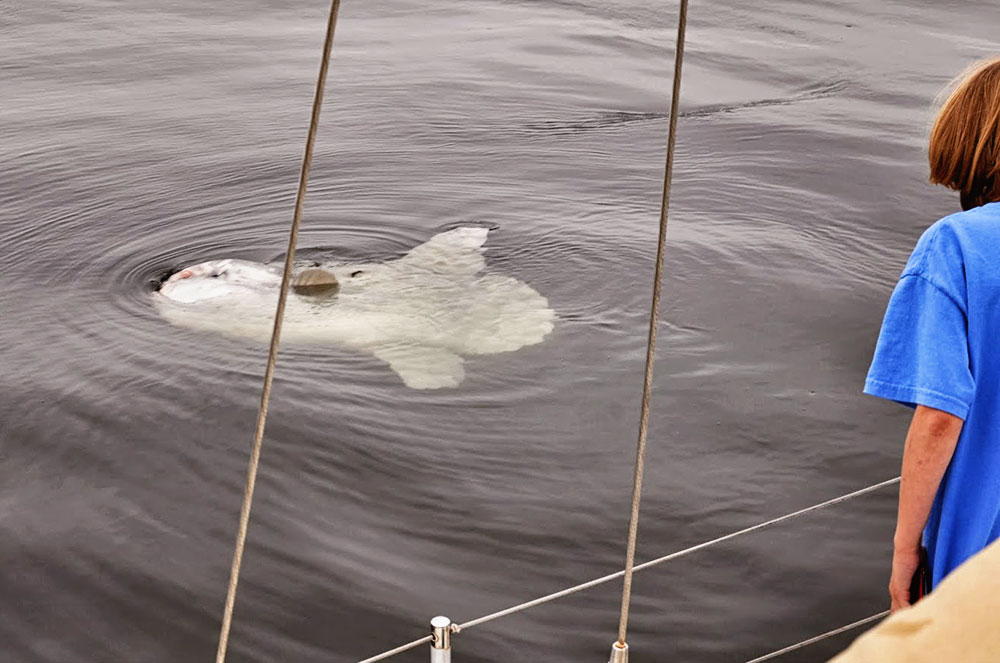
On the wildlife front, it was about a week earlier and a bit further north that we saw our first and only sunfish, about 15 miles offshore. They’re the largest bony fish on earth. They’re flat and tail-less and occasionally hang out on the surface like this. They eat jellyfish, which makes sense as that part of the world is teeming with jellyfish.
Because he told the story that we can’t get out of our heads and because it must be the most unusual thing ever, we’ll give Rick Lamb the first word… –Eds.
***
The most unusual wildlife thing: a squirrel that must have choked while carrying a nut. It was when I was rowing an aluminum boat on an Indiana pond. The squirrel was dead and floating in the water, but the nut had sprouted and the tendrils of roots and leaves were growing from its mouth. The squirrel was turning into a tree, presuming it would wash ashore where the roots could hold.
–Rick Lamb, Carmel, Indiana
Probably about 1980 or ’81, headed to the BVI from Lauderdale, 120′ Feadship. Very calm, gorgeous, mirror sea, and clear blue sky. Making 10 knots, probably about 20 miles off Great Inagua. Something odd off the starboard bow prompted a “let’s go see” course change.
A perfect, complete, probably 8-foot-long sofa with all the proper cushions in place, including arm rest covers, dark brown leather, just drifting along. NOT sinking! Just looked like you could stroll right over, plop down, turn on the TV and grab some popcorn in time for the show!
–John Sims
One of the draws of being a snowbird (who heads south to Florida from Ontario to escape the cold of winter) is being able to see wildlife we don’t see up north in our neck of the woods. Alligators, dolphins, and pelicans, are all good examples—or they all were until a couple years ago. It was a couple years ago, boating in Hamilton Harbour, when I was shocked to see what looked like a single white pelican floating about. This great bird dwarfs the ducks, Canadian geese, and swans which are common in Lake Ontario. I checked in with a friend of mine who happens to be a birder. He assured me I had lost my mind. And then the local paper backed me up. Apparently, pelicans occasionally stop in our waters on their migratory journey. Who knew?
–Lee Brubacher, Hamilton, Ontario
Man-made: once came across a refrigerator floating in the Bay of Fundy, going out with the tide. No idea where it might have come from!
Wildlife: one day late this summer, I found a hummingbird doing the breast stroke a mile or so offshore. After a challenging MOB drill, managed to get it aboard. It was quite a warm day, so hoped it would dry off and warm up but the little guy didn’t make it. He (?) was buried with full honors in my wife’s flower garden.
–Gord Phillips, Lord’s Cove, New Brunswick
I spotted something while sailing a few years ago. I moor and sail my boat at a local lake in Alberta and I do frequent over-nighters on my boat to enjoy the wildlife as well as the sunsets and sunrises. After one such night on my boat, I had breakfast and a leisurely coffee before setting sail for the homeward trip. I was just getting under way when I spotted a white object floating just beneath the surface of the water about 50 meters away. I carry a small fishing net and I am in the habit of scooping up garbage that finds its way into “my” lake.
I changed my heading and went straight for this garbage. As I drew closer I could see that it was actually a dead fish, not an uncommon find on the lake, unfortunately. It looked quite large so I got closer to investigate. Turns out it wasn’t a fish, but two fishes, a smaller one was firmly lodged in the mouth of a larger one! A glaring example of “biting off more than one can chew!” Of course, I had brought a camera with me on that trip, but I’d neglected to charge the battery.
–Mark Stricklin
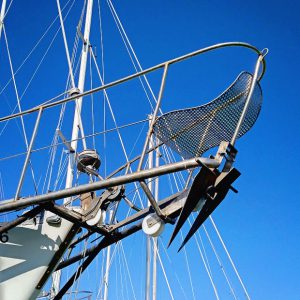 I hope this qualifies for your a most unusual inanimate object (man-made thing). Without reading further, can you guess what the photo is about?
I hope this qualifies for your a most unusual inanimate object (man-made thing). Without reading further, can you guess what the photo is about?
This is a photo of the bow of a boat I spotted at Havre Polyvalent-Ste-Anne-des-Monts, on the St. Lawrence River off Quebec, Canada. I could not for the life of me see why someone would want a splash guard on the bow of their boat. Upon closer inspection, I realized it was a seat for a pedal-powered windlass! Cool or what?!
–David Takahashi, Chikara-Ni, Alberg 37

